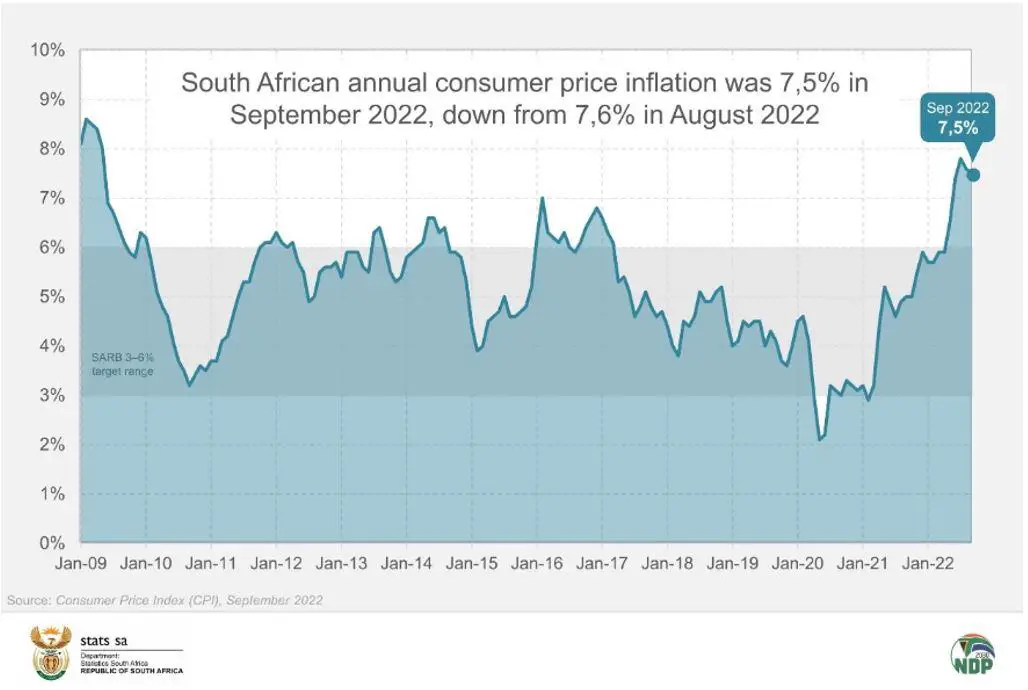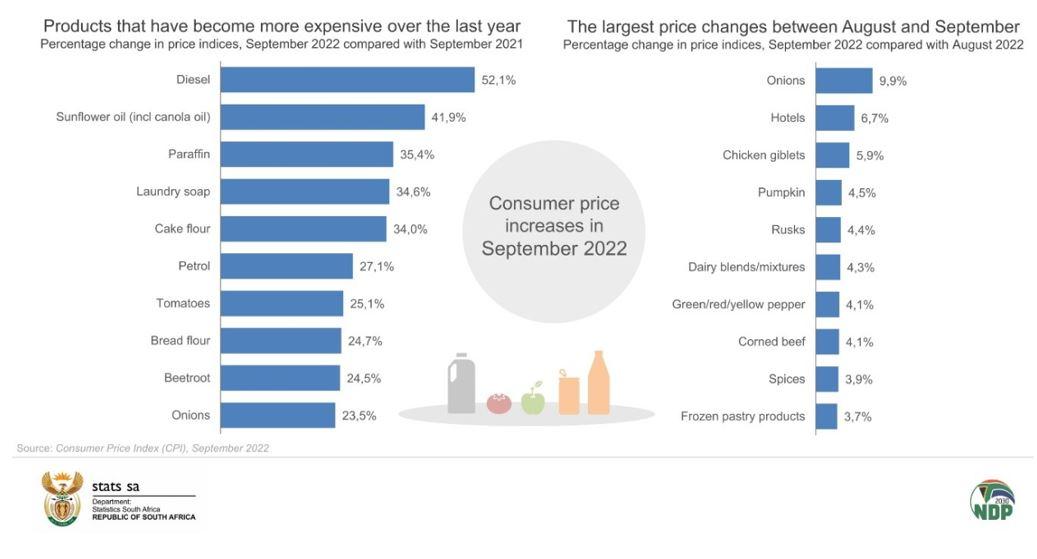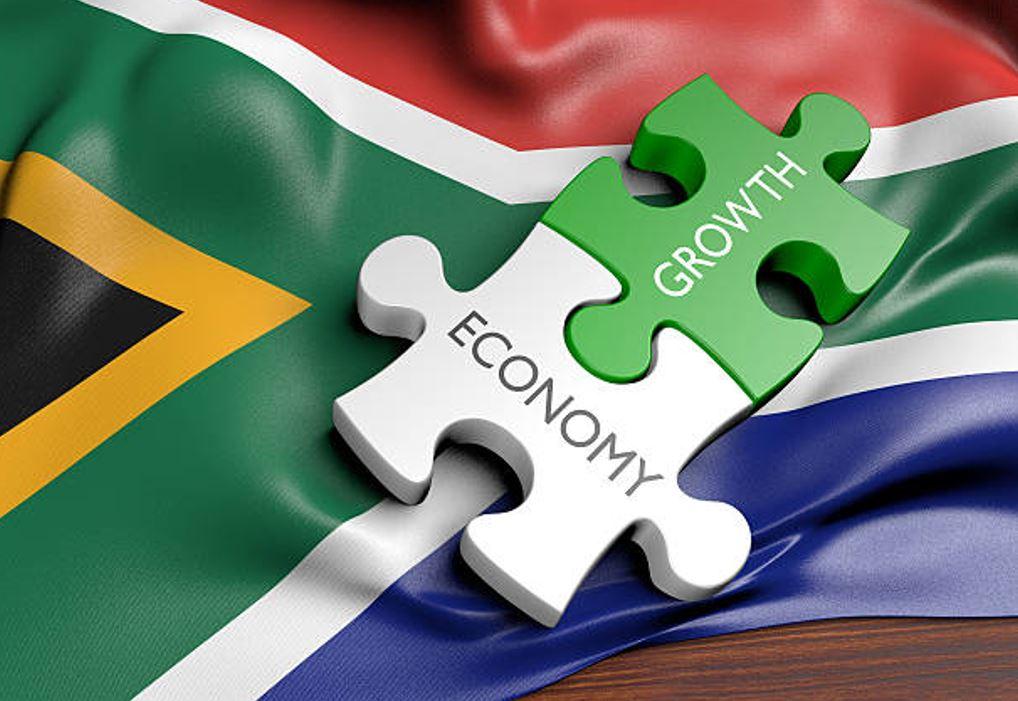South Africa's economic performance in 2022 was mixed.
The country, which has been plagued by slowing economic growth, has managed to stem the flow of negative news. The country's National Statistics Office reported that the country's inflation rate is slowing. The Bureau of Statistics reported in September that inflation had slowed for the first time in two months.
“Annual consumer price inflation slowed to 7.5% in September from 7.6% in August, falling further from the 13-year high of 7.8% hit in July. “This continued decline contributed to the softening of headline interest rates,” the agency said. Website Note.
- South Africa's economic growth in 2022 was weak. Macroeconomic fundamentals and indicators indicated that inflation would slow in the third quarter of 2022.
- The slowdown in South Africa's inflation indicators contrasts with the general inflation trend prevailing globally.
- However, as in other parts of the world, inflation in South Africa was driven by rising food prices, which were themselves driven by rising raw material costs.
This positive development is in contrast to what usually fills newspaper space in the media. Inflation is rising globally, which, combined with low growth, is creating stagflation. South Africa's report of slowing inflation is exemplary.

According to Stats SA, South Africa's inflation in 2022 was driven by sharp increases in food, non-alcoholic beverages and fuel prices. This position is consistent with the global narrative that inflation is caused by demand-pull factors such as excess liquidity, which creates more demand than supply. Inflation around the world is driven by supply disruptions and cost drivers from rising prices of raw materials, namely energy, fertilizers and food.
The South African government agency further added: “The CPI excluding these two categories rose 4.9% for the year, up from 4.6% in August, indicating that the rise in inflation extends beyond these two categories. ” ” The slowdown in inflation is a result of falling fuel prices, which fell by a significant 6.4% from August to September. The government, through its agencies, has acknowledged that although commodity price levels continue to rise, they have slowed down in the August-September period of 2022.
Mozambique: Overcoming the debt trap and becoming the South of Africa
Inflation for bread, cereals, and meat showed a similar pattern. The annualized rate of return for bread and cereals accelerated to a 13-year high of 19.3% in September. The monthly interest rate was 1.3%, softer than his 3.1% in August. Annual meat inflation increased from 9.2 percent to 9.9 percent, but the monthly reading slowed to 0.5 percent from 0.7 percent. While lower fuel prices should provide some respite for consumers, the cost of living in other categories remains high.
- Sovereign debt levels in the South African economy remain worryingly high despite the country achieving positive traction in other areas of the economy.
- South Africa's public debt stands at 71.4% of GDP, compared to the IMF recommended level of 40%. This is a macroeconomic trend common to several African countries with unsustainably high levels of debt.
Food prices are starting to settle, as are fuel costs, but there are noticeable increases across the board due to increases in rentals, clothing, lodging services, and personal care. The continued increase in these cost categories has a direct and negative impact on consumers.

This is the country's position on inflation. Finance Minister Enoch Godongwana delivered a medium-term budget statement last month, in which he struck a strong note of optimism. This is according to an article published by luxury investment bank Investec titled 'Medium-term Budget: Godongwana strikes an optimistic tone'.
The article, written by the bank's chief economist Annabelle Bishop, highlighted the key MTBS themes of improving GDP and reducing borrowing. The article noted that gross debt is projected to peak at 71.4% of GDP in 2022/23, earlier than the previous peak estimated at 75.1% of GDP in 2024/25. ing.
Read: Cape Verde’s national debt and economic profile
What this means is that South Africa has managed to reduce its debt on its books relative to the size of its GDP. Despite this positive economic development, it should be noted that the debt-to-GDP ratio is still quite high, but not as high as in other countries on the African continent.
The IMF recommends that sustainable debt levels should be around 40% of GDP, but South Africa remains at least 31 percentage points above the optimal debt-to-GDP ratio, regardless of positive traction on this front. ing.
The amount of debt on a country's books can become inflated when a variety of factors occur. The first is when the debt is denominated in a foreign currency and the value of the borrowing country's currency depreciates or begins to decline, or the interest rate on the borrowing currency begins to rise.
This increases the cost of borrowing and servicing that debt. To be able to meet their loan obligations, countries will have to raise taxes, with the effect of reducing consumer income and increasing the cost of goods and services. If the debt is denominated in the local currency, as in Eritrea, the same government can simply postpone the debt's maturity forever into the future.
If the government in question has to repay its debt in local currency, it can extract money out of thin air by increasing the level of money supply in the economy. Therefore, a country's debt-to-GDP ratio is always an important indicator for stakeholders to keep an eye on. South Africa is on the right path in terms of paying down its debt.
“The decline in the ratio is due to a partial decline in borrowings and a surplus in revenue, but importantly, the Treasury has revised its GDP forecast upwards to take into account higher inflation, and both the total loan debt and deficit ratio have increased. as a percentage of GDP. The fiscal deficit for 2022/23 is now expected to be -4.9% of GDP for the current fiscal year, compared to -6.0% of GDP for the current fiscal year as expected in February,” Investec said.
- Excessive public debt can have a negative impact on certain economic indicators such as inflation, especially in an environment of cost-push inflation and weak local currencies. This is a macroeconomic vulnerability that South Africa cannot afford.
- South Africa is repaying its debt favorably and its debt-to-GDP ratio is expected to decline.
Fiscally, South Africa is expected to run a budget deficit of -4.1% in 2023, but the deficit is expected to narrow over the next three years to -3.6% by 2026. This represents significant fiscal consolidation.
Over the next three years, the South African government expects to strengthen its public finances and reduce its budget deficit, particularly by increasing revenue and controlling or containing costs. According to Investec, “In the current financial year (2022/23), high inflation pushed up nominal (actual) GDP significantly, easing both fiscal debt and fiscal deficit-to-GDP forecasts; It is a measure of a country's growth that boosts real GDP, which removes the distorting effects of inflation. ”
Among African countries, South Africa is developing public finance legislation. The country is paying down its debts and inflation is showing a strong downward trend. What remains to be seen is whether this decline in inflation will continue.
The government is strengthening its fiscal position, as evidenced by the reduction in the budget deficit, which is expected to narrow in the coming years. Inflation has played an important role in reducing the amount of debt on government books.
In terms of trade, South Africa Due to high mining and mineral prices, foreign currency inflows from mineral exports are very strong. The currency is depreciating, reaching a low of R18.15 against the US dollar.
However, it is important to note that the rand's weakness is not entirely indicative of deteriorating macroeconomic fundamentals, but rather is due to the strengthening of the US dollar.

